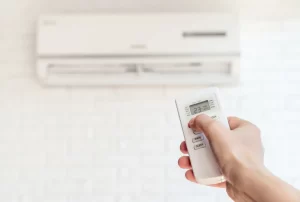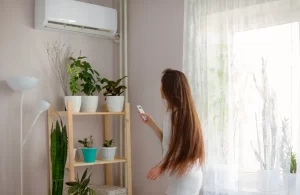Are you experiencing a dry chill indoors despite running your air conditioner? Or perhaps, on days of high humidity, your home feels more like an icy tundra than a cosy retreat? If so, it’s time to address why your air conditioner is blowing dry air and how it might be affecting your comfort and home.
At Smartway Air Conditioning, we know how uncomfortable dry air can be, stripping your home of essential moisture. In this article, we’ll explore what causes dry air from your air conditioner, the symptoms to watch for, and how you can take action.
Key Takeaways
- The “dry mode” on your air conditioning system removes excess moisture from the air, improving indoor humidity levels, while the “cool mode” focuses on lowering air temperature.
- Simple methods such as using plants, fish tanks, water containers, fountains, or humidifiers can help increase humidity and reduce dryness caused by air conditioning units.
- Adjusting your air conditioning settings and incorporating humidity-boosting solutions can enhance comfort, protect your home, and potentially lower energy costs.
How to Optimise Your Air Conditioner for Comfortable Humidity Levels
Fluctuating humidity levels can make you uncomfortable and sweaty. Often, we turn the “cool” setting on our air conditioner, thinking it’s the best way to manage our temperature. However, adjusting the settings can also help control indoor humidity for a more comfortable environment.
Each air conditioner has different settings that, when used correctly, can enhance its efficiency, save on energy costs, and ensure a cosy home. The “dry mode,” available in many ducted and reverse cycle systems, is particularly useful when humidity is high but the temperature isn’t excessively hot.

What is Dry Mode?
The dry mode and the “cool mode” on an air conditioner can often be mistaken for each other. While The dry mode on an air conditioner is different from the “cool” mode. While both settings might seem similar, they serve distinct purposes. The cool mode, often indicated by a snowflake icon, is designed to cool the air, whereas the dry mode, represented by a water droplet icon, focuses on removing excess moisture from the air.
How Does it Work?
Humidity levels vary with the seasons, just like temperature. The dry mode reduces excess humidity, which, in turn, has a cooling effect. While similar to the cooling mode, it operates differently regarding temperature regulation.
In cooling mode, the air conditioner continuously circulates and cools the air until it reaches the desired temperature. The dry mode, however, focuses on decreasing humidity and moisture, which can be particularly helpful in high-humidity conditions.
Tips to Reduce Dryness with the Right Humidity Level
Dry air can cause discomfort and health issues, including dry skin, chapped lips, respiratory problems, and damage to furniture. Maintaining the right humidity level can help address these issues and create a more pleasant living environment.

Here are five ways to remedy indoor dry air from your air conditioner:
Decorate with Live Plants
One of the best strategies to deal with a dry environment is adding more plants to the decor to raise the humidity levels. Plants add moisture to the air in space because they are a part of nature. You may easily lessen dryness by having them in every area and by artistically placing several potted plants throughout your house or office.
When the air conditioner starts to dry up, the plant can release moisture into the atmosphere, which also helps retain moisture. Just be sure to keep the plants well-maintained and to water them frequently to prevent them from drying out. Moreover, plants improve the room’s humidity and make it more aesthetically pleasing and breathable.
Add Fish Tanks
A fish tank allows you to care for pet fish while also enhancing the room’s aesthetics, increasing humidity and reducing dryness. Maintaining fish tanks in an air-conditioned space is a clever and beneficial approach to getting rid of dry air.
If you decide to add fish tanks, be sure you have the resources to offer your additional fish the care they require and to maintain clean, fresh water. Ensure the top of the fish tank is left open to encourage water evaporation and raise the air’s moisture content. Note that the water needs to be changed frequently to meet the demands of your fish and keep the area free of unpleasant odours.
Make Use of Water Containers
Using water containers will increase the humidity levels in air-conditioned spaces. Put several of them in various rooms of your house or place of business, fill them with water, and leave the lids open to let the water evaporate. The humidity in the space rises as the water evaporates.
Despite what you may believe, you can use coloured containers or clear glass as decorative water holders to avoid making your space ugly. Pebbles can be added for decorative purposes and as a practical humidity enhancer. If you adopt this option, exercise caution because the containers must be kept safely in places free from hazards.
Place a Water Fountain
A water fountain is one of the best methods for raising a room’s humidity level. Water fountains lessen the dryness brought on by air conditioners and make lovely additions to any room or workplace.
There are countless options for artistically made fountains that come in a wide range of forms, designs, and colours to suit your home and personal preferences precisely. Set up your lovely water fountains in several thoughtful locations throughout the space for the best results in increasing room humidity.
Install a Room Humidifier
Adding a room humidifier is one of the easiest yet most efficient ways to raise the humidity in air-conditioned spaces. These devices are specifically made to add wetness to any space to enhance comfort.
Many people mistakenly believe they only need one humidifier for a single room. It is best to humidify your entire home or place of business, including any spaces where the air conditioner is used. Humidifiers must also be cleaned regularly for best results and peace of mind from producing pure moisture in the air.
Benefits of Good Indoor Air Quality Using Your AC System’s Dry Mode
The health of your family and a comfortable environment are just two advantages of balancing air moisture and keeping optimum humidity control in your home environment.

The dry mode can accomplish the following benefits when used properly and under the right circumstances:
- More Efficient System: Less energy is used in the dry mode because your air conditioner’s compressor runs more slowly. Utilising it more frequently will minimise your energy expenditures and benefit the environment by reducing your home’s carbon footprint. Switch to the dry mode when it’s only humid since using your unit’s cool mode frequently in warmer weather isn’t energy-efficient.
- A Healthier Environment: The dry mode’s dehumidification procedure maintains indoor air at its ideal relative humidity, which helps enhance air quality and lessen the sweatiness, clamminess, and fatigue frequently linked to excessive humidity levels.
- A better-protected home: High humidity levels can also accumulate moisture (and consequently, mould and mildew) over time, frequently resulting in the dreaded “musty odours.” It may be found on clothing, bed linen, curtains, furniture, and other items.
Discover Comfort with SmartWay Air Conditioning Services Today | Over 30 Years of Experience
At Smartway Air Conditioning, we specialise in transforming your home into a comfortable sanctuary, regardless of the season, with professional air conditioning services. Our expert team is dedicated to addressing all air conditioning issues, ensuring that you enjoy optimal humidity levels with our advanced air conditioning solutions.
Our cutting-edge technologies and personalised solutions ensure that every corner of your home receives the perfect balance of comfort and efficiency. Whether you need to adjust your air conditioner’s settings, repair a faulty system, or upgrade to a new AC unit, SmartWay Air Conditioning is your go-to partner. We prioritise your satisfaction and work diligently to deliver top-tier services that are both effective and affordable.
Choose Smartway Air Conditioning for unmatched expertise, exceptional service, and a commitment to customer satisfaction. Contact us today to receive a free estimate.
Frequently Asked Questions
What is the function of a cold evaporator coil inside the air conditioning unit?
The cold evaporator coil on an air conditioner helps to cool down the air inside a room or space. It absorbs heat and moisture from the warm air and then releases it outside as cooler, drier air. This process is known as dehumidification.
Why is the air in my home feeling dry even though my air conditioner is running?
When your air conditioning system is running, it can make the air in your home dry if the cooling coil temperature is too low or the air conditioning units are not properly managing indoor humidity levels. The air conditioner dry effect results from the system removing excess moisture while cooling the warmer air.
How does an air conditioning system’s “dry mode” help with indoor humidity levels?
The “dry mode” on air conditioning systems helps manage indoor humidity levels by reducing the moisture in the air without significantly altering the air temperature. This mode ensures the air conditioning system provides cool air while keeping the cooling coil temperature optimal to prevent the air from becoming too dry.
Can kitchen and bathroom fans help the excessive humidity environment the air conditioner makes?
Yes, kitchen and bathroom fans can help reduce the excessive humidity environment created by air conditioners. The fan and compressor speed up the humid air and draw in outside air, which can help provide fresh, dry air.
Conclusion
Addressing the issue of dry air from your air conditioner is crucial for maintaining a comfortable and healthy home environment. By understanding the difference between the “cool” and “dry” modes on your air conditioning system and implementing simple solutions like adding plants or using a humidifier, you can effectively manage indoor humidity levels and ensure that your home remains a cosy retreat. Remember, proper humidity control enhances comfort, protects your furnishings, and improves air quality.
At Smartway Air Conditioning, our Sydney expert team is ready to assist with any air conditioning issues you may face, ensuring your home remains comfortable year-round. Contact us today to schedule your consultation.



